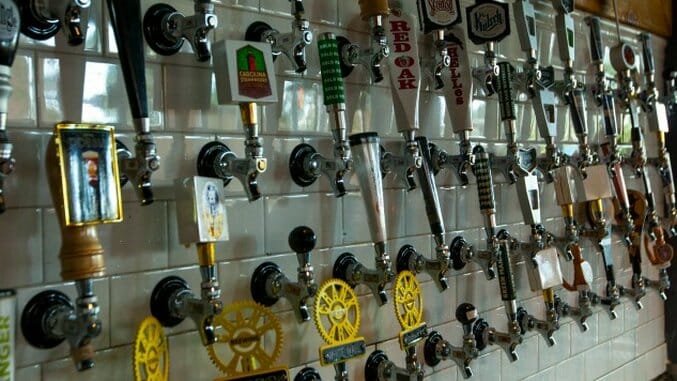
It’s happened to veteran bar fly and casual drinker alike: that moment of panic when the bartender asks what beer you want and you have no idea. You could wave them off, but that bachelorette party just showed up and is threatening to monopolize the barkeep’ s precious time. You could order the usual, but you came to this bar because of their wide selection. To order a Bud Light is to admit defeat. In a desperate ploy, your eyes dart to the tap display. You see a chorus of handles ranging from carved woodland creatures to repurposed bicycle gears. Without reading it, you order the beer with the skeleton playing guitar on a surfboard.
That decision which took two seconds of your brainpower is something that craft brewers think about a lot. But what makes a good tap handle? Most people agree that the best ones attempt to form a link between the drinker and the brewer, tell a story about the beer and effectively skirt the line between ornate and sleek.
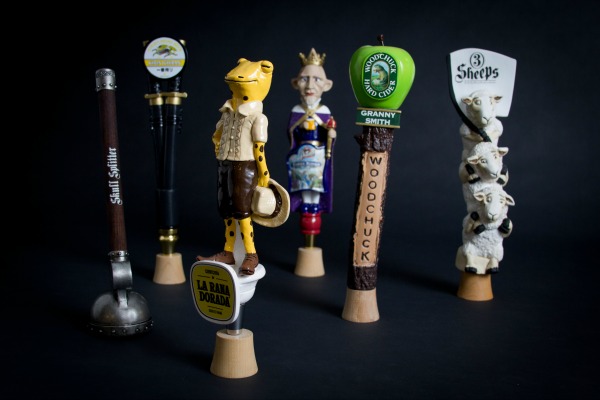
Tap handles are the most powerful piece of marketing available to brewers at the point of purchase, and the market has never been more crowded. According to the Brewers Association, between 2014 and 2015 alone, the number of regional craft breweries in the U.S. increased by about 32%. Great tap handles can help beers find new fans, while mediocre handles can sentence good beers to the echelon of un-drunk ales.
Brian Thomas, who runs the blog and online museum Amazing Tap Handles, says any good handle is trying to tell you a lot more than how hoppy the beer is. “The tap should suggest to someone who looks at it that there is a story to tell,” he says. “That story should be about the brewery, a personal connection to the brewery’s owner, or a particular beer.”
While a narrative may not feel like the first thing you notice about a handle, establishing one is pretty important for breweries who want to build a following.
George Esquivel, a co-founder of Dallas brewery Four Corners Brewing Co, says that handles should have a deep connection to the brewery’ s story. Four Corners’ taps are all designed to look like Lotería cards, a traditional Mexican game, to pay homage to where the founders came from.
“The West side of Dallas is very Hispanic,” said Esquivel. “We take a lot of cues from the places where we grew up. The neighborhoods we know really well have all these little gems that don’ t pop up on reality shows. That’ s the real Dallas that we try to highlight with our taps. The Lotería seemed like a great way to express that.”

Four Corners’ bestseller, Local Buzz, is a nod to the Dallas gardens where Four Corners sources their honey. The Paletero, a pale ale, was designed after the ice cream vendors who roam the Dallas streets.
Although the average drinker may not understand all these symbols, they have enough impact to keep people coming back. Esquivel says that even if someone doesn’ t remember the name of the beer they enjoyed, they still recognize Local Buzz as ‘ that good beer with the bee on it.”
NOLA Brewing Company also uses tap handles to convey a story about their brewery. Kirk Coco, the CEO and founder, was in the Navy when Hurricane Katrina hit New Orleans in 2005. A native of the city, he vowed to go back and rebuild it however he could. He was drinking in a bar when the inspiration for NOLA Brewing Company hit him.
“Sometimes when you’ re drinking, you get this amazing focus,” said Coco. “I was at a bar drinking Dixie beer, because I wanted to support a local company that had been in New Orleans since the early 1900’ s. I looked at the bottle and on the side it said ‘ brewed and bottled in Wisconsin.’ That really got me angry. A few drinks later, I decided that I was going to start a brewery.”
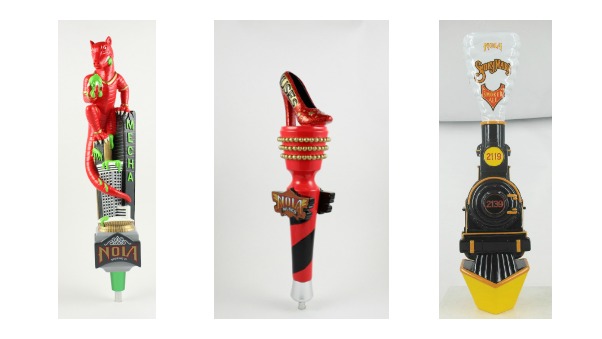
To pay homage to the city that raised Coco, most of NOLA Brewing Company’ s taps have some relevance to New Orleans. He says that integrating New Orleans
landmarks helps NOLA Brewing Company appeal to locals and visitors alike. “Our Smoky Mary beer refers to this old train that everyone’ s forgotten called the Smoky Mary,” he said. “I wanted to make a tap handle that looked exactly like that old train. Nobody looking at the handle may pick up on these little things, but it’ s the most fun part of my job.”
NOLA Brewing Company’ s Hopitoulas (named after Tchoupitoulas street) was designed after the tiles that line all of New Orleans’ street corners. Their Muses beer features a red stiletto, which is emblematic of the popular Mardi Gras parade.
Coco says that when a handle is done well, it can be the driving force behind a beer’ s success. He credits the success of NOLA’ s Brewing Company’ s IPA, Mecha, largely to the extravagant handle design.
“We released an imperial IPA when nobody was selling IPAs. We thought it would not sell, so we only made a little a bit,” said Coco. “But our Mecha handle had a monster climbing on the Superdome and some other famous buildings. Bar owners didn’ t know what the beer was, but they wanted it because the handle was so awesome. We moved a lot of kegs because the tap handle looked so cool.”
While the uniqueness of Mecha had a clear benefit for NOLA Brewing Company, there are arguments that the individuality of a handle can work against it. A core decision at the root of many tap handle designs is choosing between being a branded house or a house of brands. To put it another way, do you want people to remember your brewery or your beer? The former would favor uniformity among taps in the hopes that patrons recognize and trust the brewery. The latter focuses more on the individual beers, leaning towards intricate designs.
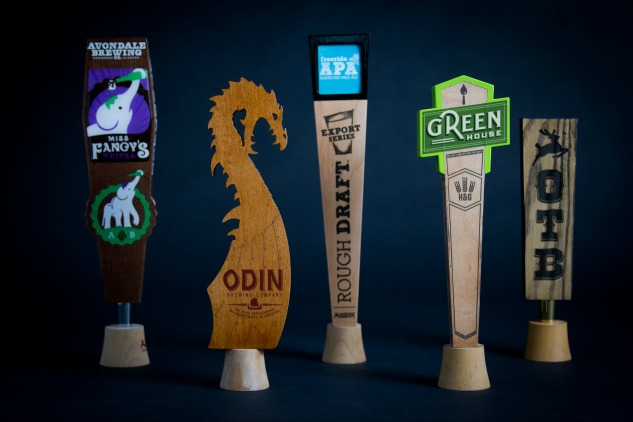
Mark Steinhardt is the general manager of the leading handle manufacturer, AJS Tap Handles. They sell about a half-million handles each year to thousands of breweries from ‘ Anheuser-Busch to Coors and everyone in between.’ Steinhardt says that he sees many brewers choose to design their handles with more homogeneity, to build up a central brand.
“The common wisdom seems to be that you should have a theme for all your tap handles, regardless of the variety,”said Steinhardt. “Especially with the number of seasonal beers, a lot of brewers want standard designs and graphics on their handles.”
Esquivel agrees that if you want to build a larger fan base, people need to be able to recognize your beer even if they’ ve never tried it before.
“Uniformity is important,” he said. “If you’re brewing good stuff, then you want people to try new things from your portfolio and know that it’ s quality across the board. We’ ve tried to build our reputation so people know that any of our beers will be solid. Some brewers break away from that and try to build a platform of beers versus a brewery brand.”
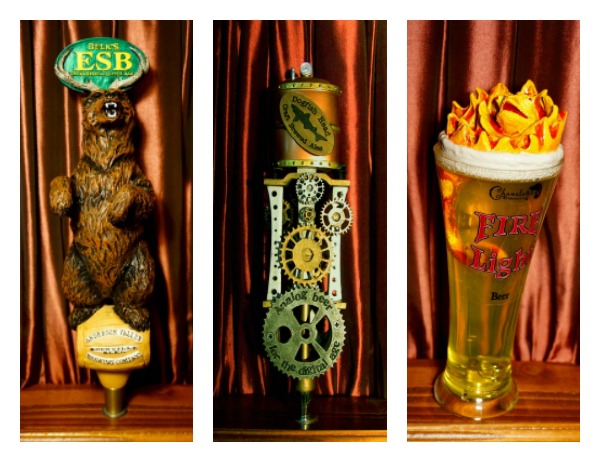
NOLA Brewing Company would fall more into the latter category. Their library of handles is as diverse and colorful as a line of parade floats, but it’ s hard to find a common visual thread between them. While a patron may be equally intrigued by a dinosaur handle and a big red stiletto, they’ d probably be hard-pressed to figure out they’ re coming from the same brewer. However, Coco says that the differences in NOLA Brewing Company’ s handles are telling a different story – a story of variety. He says that his beers are all so different that unique handles are the only way to really do them justice.
“Companies who put out 12 tap handles that look alike really do their brand a disservice,” said Coco. “It shows that they have ownership, but it doesn’ t show any difference in the beers. My marketing manager was adamant that our tap handles look alike and I did not follow that at all. All of our beers are unique and I wanted a creative way to show that.”
Of course, the handle’ s story also has to go deeper than the brewery. It’ s primary function is to get you to order a beer, and it would be doing a poor job if it didn’ t tell you something about what you’re ordering. “When you’re out at a bar with 20 taps, the only thing people can judge your beer on is that handle,” said Coco. “I’ ve seen people order a beer then accuse the bartender of making a mistake because it’ s a light beer but the dark handle made it look like a stout.”
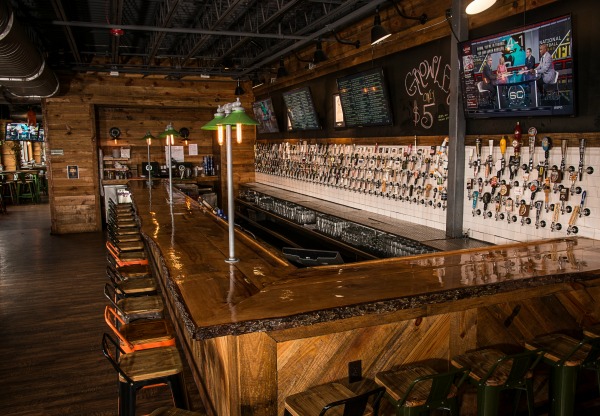
Once a brewer figures out how to convey its story through the handle, they still need to design something attention-grabbing. “In a crowded market with crowded tap displays, uniqueness and visibility to a customer is imperative,” said Niall Hanley, owner of the Raleigh Beer Garden, which holds two tap-related world records: largest variety of unique draft beers on tap and largest variety of breweries on draft. “Especially if that customer is not accustomed to local beers, unique handles speak to the variety that is offered and jump out more.”
Jumping out is more important than ever. In addition to the growing number of craft brews, taps are also being invaded by wine and even vodka these days, with brands like Tito’ s vying for precious tap space. Large brewers are also putting more budget towards releasing new handles. According to Cole Krueger, lead designer at AJS Tap Handles, big brands are able to use their considerable resources to experiment more with handles. “Coors and Miller will do test market runs before they roll out new handles to see how well they perform,” he said. “They have people who keep stats on what’ s actually selling beer in this market. With bigger brands, the tap handles that have thenboldest look with the largest and most visible logos tend to do the best.”
Krueger said that one strategy a lot of smaller breweries will adopt to stay competitive is to have a base handle with interchangeable magnetic labels they can slide in and out as their beers change.
No matter the branding strategy, most good tap handles will elicit an emotional reaction with the drinker. “There should be a little mystery about the tap that makes it intriguing,” said Thomas. “And humor, not crassness or obscenity, but rather tongue-in-cheek wacky characters or just plain craziness, is always appreciated.”
There are also some technical considerations that go into a quality tap. They won’ t make a handle amazing, but overlooking them could make it hard to get your handle behind the bar. “Good taps are highly visible and nicely balanced to avoid rocking and thus accidental pouring,” said Hanley.
“The handle needs to fit in a certain envelope,” said Reinhardt. “If it’ s too big, it won’ t get into every bar because it just doesn’ t fit. If it’ s too wide, it will turn sideways and patrons don’ t get a view of it.”

According to Krueger, a handle also needs to stay under one pound or it will pull a tap line open on its own. He also said a good tap should be no more than three inches wide and between 10 and 12 inches tall. Ambitious brewers who try to work outside these constraints often see their handles removed for being too cumbersome.
There are also some pitfalls to avoid when designing a new tap. A common design mistake that brewers make is going too ornate or intricate with their handles. “Anything overly complex doesn’ t make for a great handle,” said Krueger. “Sometimes people get too caught up in a crazy tap handle idea that they forget about having it be visible. With any handle I design, I try to refrain from having many sculptural elements that will fall off. Bars won’ t put them on the tap line if they’re always breaking.”
As far as themes he sees a lot of, Krueger says the popularity of IPAs has lead to some recurring handle designs. “Hops are a big motif right now, with hoppy beers and IPAs being really popular. People also want to see taps with more rustic elements like rough wood grains and brass and copper fittings.”
I wasn’t able to find a design silver bullet that works for every tap handle. What may sell one beer could do terribly for another. Tap handles, like any art form, are subjective experiences. At the end of the day, beauty is in the eye of the beer holder.